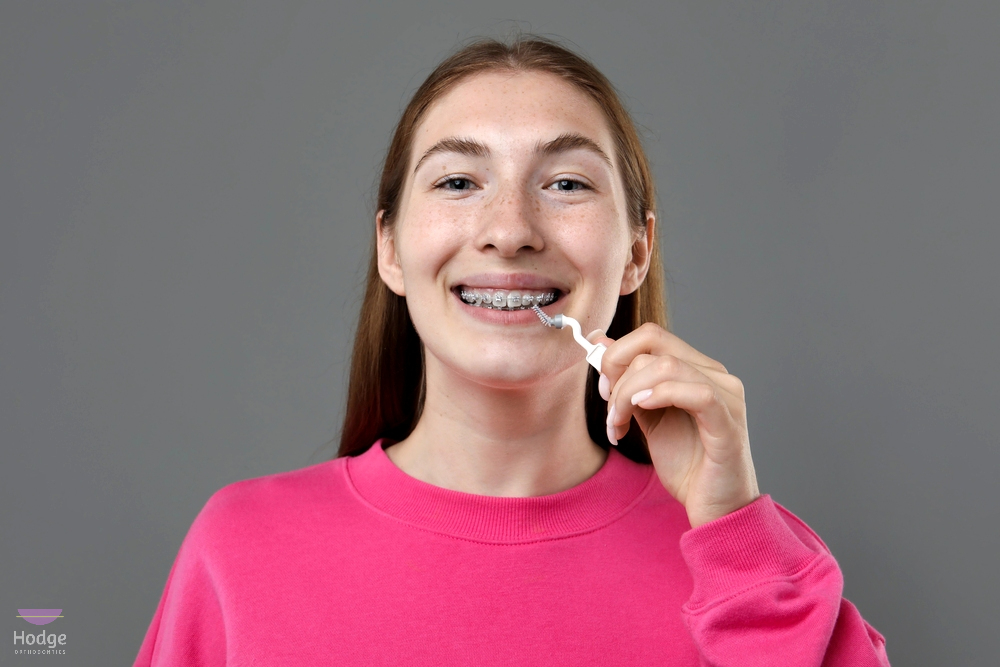Are you trying to figure out how to floss with braces in Little Rock, AR? Don’t worry, you’re not alone! Flossing can feel tricky when you have braces. The wires and brackets often catch food particles and plaque. With the right flossing techniques and tools, though, keeping your braces and teeth clean becomes much easier.
Keep reading to learn simple ways to floss with braces and the best tools to use. 
Why Flossing with Braces Is Essential
Braces straighten your teeth, but they create small gaps where food and plaque can hide. If not cleaned daily, these spots can lead to cavities, gum disease, or tartar buildup. Brushing alone won’t clean all the surfaces around the wires and brackets. This is where flossing helps. Adding flossing to your daily oral hygiene routine removes plaque and keeps your orthodontic treatment effective and on track.
Tools to Make Flossing with Braces Easier
Using the right flossing tools can save time and make cleaning easier. Here are some great options:
Floss Threaders
A floss threader acts like a needle. It helps guide floss under the archwires of your braces so you can clean between teeth. These tools are beginner-friendly and gentle on your brackets. Floss threaders make it easier for anyone new to flossing with braces.
Water Flossers
Water flossers spray water to remove plaque and food particles from hard-to-reach areas. They are perfect for people with sensitive gums who want an easier option. A water flosser cleans effectively around braces, wires, and the gum line while being gentle on your mouth.
Superfloss
Superfloss is pre-cut floss with stiff ends that slide under archwires. It also has soft, spongy sections for cleaning plaque near the gum line. Superfloss is handy when you need a quick solution for your braces cleaning routine.
Interdental Brushes
Interdental brushes, also known as proxabrushes, are tiny brushes designed to clean between teeth and braces. These brushes reach spots traditional floss may miss, ensuring thorough cleaning around brackets and wires.
Floss Picks
Floss picks have a handle and a strand of pre-threaded floss. They are quick and easy to use, making them great for people who are always on the go. Floss picks also make flossing less time-consuming.
How to Get Flossing Tools
Flossing tools like threaders, water flossers, superfloss, proxabrushes, and floss picks are available at most stores. You can find them at pharmacies, online retailers, or specialty dental stores. Many orthodontic offices, including Hodge Orthodontics in Little Rock, AR, may also offer flossing kits to help you maintain your oral care routine.
Simple Steps to Floss with Braces
Flossing takes practice, but once you build good flossing habits, it becomes second nature. Follow these easy steps:
Step 1: Get Ready
Cut about 18 inches of floss. Use a floss threader if you are working with traditional floss. Thread the floss under the wire and prepare to clean each tooth.
Step 2: Clean Around Each Tooth
Gently wrap the floss into a “C” shape around one tooth. Move the floss up and down to remove food and plaque from the gumline and tooth surface. Be gentle so you don’t damage your gums or braces.
Step 3: Use a Water Flosser for Extra Help
If you find string floss difficult, try a water flosser. Adjust the water pressure so it feels comfortable for your gums. Focus the water jet around the brackets and wires to ensure you remove all stubborn plaque and debris.
Step 4: Finish by Brushing
After flossing, it’s time to brush. Use a soft-bristle toothbrush and fluoride toothpaste to clean all surfaces of your teeth and braces. Spend two minutes brushing to remove any leftover debris. Rinse with a fluoride mouthwash to strengthen your teeth and protect them from plaque buildup.
Flossing Based on Different Types of Braces
Each type of brace may require slight adjustments to your flossing routine. Here are some tips:
- Metal Braces: Carefully thread the floss under each wire and clean around the brackets.
- Clear Braces: Use gentle motions to avoid damaging the delicate clear brackets.
- Lingual Braces: These braces are on the back of your teeth, so use a proxabrush or water flosser to clean effectively.
- Self-Ligating Braces: Though these have fewer components, thorough cleaning under and around the wires is still crucial.
Common Challenges and Solutions for Flossing with Braces
Problem: Sensitive Gums
Solution: Gum tenderness is common at first. Rinse your mouth with warm salt water to ease soreness. Over time, regular flossing will strengthen your gums and make them healthier.
Problem: Hard-to-Reach Areas
Solution: Tight spots can be cleaned with tools like water flossers, proxabrushes, or superfloss. These tools make it easy to clean around back teeth and near molars.
Problem: Time-Consuming Flossing
Solution: Flossing with braces takes patience, but tools like floss picks or water flossers can help speed up your cleaning routine. Consistency leads to success. According to Dr. Latoya Callahan, a professional orthodontist in Burtonsville, MD, setting up a routine with simpler tools like floss picks or water flossers can make hygiene less time-consuming and more manageable daily.
Caring for Your Teeth After Braces
Your braces are off, and your smile looks great! Now it’s time to keep it that way. Follow these tips:
- Clean Your Retainer: Wash your retainer daily to prevent bacteria and plaque buildup.
- Floss Daily: Floss every night to remove plaque, food particles, and tartar.
- Brush Thoroughly: Brush twice a day with fluoride toothpaste to protect your enamel and keep your teeth healthy.

Expert Advice from Hodge Orthodontics
At Hodge Orthodontics in Little Rock, AR, we believe excellent oral hygiene is vital to your orthodontic care. Flossing every day prevents dental problems like gum disease and cavities. Here are some ways we support patients:
- Personalized Instructions: We teach you the right flossing methods for your braces.
- Recommended Tools: Our team suggests products like floss threaders, water flossers, and superfloss to simplify your dental hygiene.
- Preventive Care: We provide tips and tricks to help reduce plaque, protect your gum line, and create healthy flossing habits.
Make Flossing Simple and Effective
Flossing with braces takes a little extra time, but it’s worth the effort. With the right tools and techniques, you can easily keep your braces, teeth, and gums clean. If you need help with your flossing routine, Hodge Orthodontics is here for you. Contact us today for guidance, personalized advice, and demonstrations.
About The Authors
Dr. Natalia Hodge – Orthodontist in Little Rock, AR
Dr. Latoya Callahan – Orthodontist in Burtonsville, MD
Frequently Asked Questions
Is it okay to skip one day of flossing with braces?
It’s best to floss every day, but missing one day isn’t the end of the world. We all have busy or tired days sometimes! Just don’t make skipping a habit. Braces trap food and plaque easily, so regular flossing keeps your teeth and gums healthy. If you miss a day, get back to it the next night and maybe take a little extra time to clean well. Staying consistent will help you get the best results from your braces.
Is it normal to not be able to floss with braces?
Yes! Flossing with braces can be tough at first because of the wires and brackets. It takes time and patience to learn the right way. Many people with braces struggle at first, so you’re not alone. You can make it easier by using tools like floss threaders, interdental brushes, or water flossers. With practice, it’ll get much easier.
How to floss with braces without threader?
Don’t worry, you can still floss without a threader! Cut about 18 inches of floss and tie the ends to make a small loop. Use the loop to gently guide the floss under the wire and between your teeth. Move it up and down along each tooth, going slightly under the gumline. Be gentle so you don’t hurt your gums or pull on your braces. It might take a bit of practice, but once you get the hang of it, it’ll be quick and easy.
